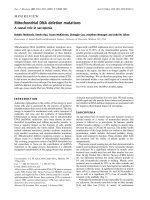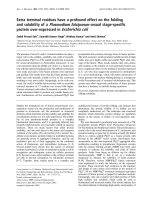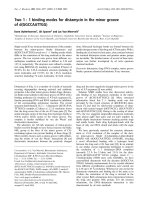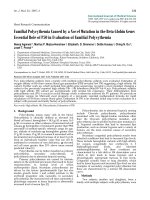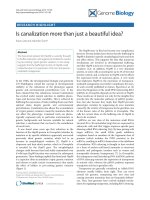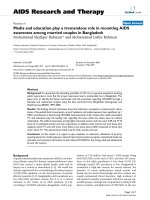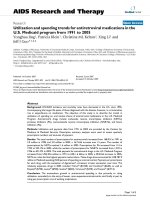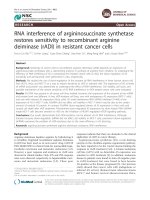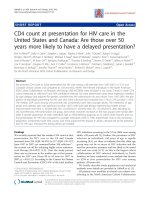Báo cáo y học: "RNA interference: more than a research tool in the vertebrates'''' adaptive immunity" ppsx
Bạn đang xem bản rút gọn của tài liệu. Xem và tải ngay bản đầy đủ của tài liệu tại đây (452.04 KB, 4 trang )
BioMed Central
Page 1 of 4
(page number not for citation purposes)
Retrovirology
Open Access
Commentary
RNA interference: more than a research tool in the vertebrates'
adaptive immunity
Johnson Mak*
1,2
Address:
1
Virology Program, Macfarlane Burnet Institute for Medical Research and Public Health, Melbourne, Australia and
2
Department of
Biochemistry and Molecular Biology, Monash University, Clayton, Australia
Email: Johnson Mak* -
* Corresponding author
RNA silencingsiRNAmiRNAHIVPFV-1vertebrateimmunityviral invasion
Abstract
In recent years, RNA silencing, usage of small double stranded RNAs of ~21 – 25 base pairs to
regulate gene expression, has emerged as a powerful research tool to dissect the role of unknown
host cell factors in this 'post-genomic' era. While the molecular mechanism of RNA silencing has
not been precisely defined, the revelation that small RNA molecules are equipped with this
regulatory function has transformed our thinking on the role of RNA in many facets of biology,
illustrating the complexity and the dynamic interplay of cellular regulation. As plants and
invertebrates lack the protein-based adaptive immunity that are found in jawed vertebrates, the
ability of RNA silencing to shut down gene expression in a sequence-specific manner offers an
explanation of how these organisms counteract pathogen invasions into host cells. It has been
proposed that this type of RNA-mediated defence mechanism is an ancient form of immunity to
offset the transgene-, transposon- and virus-mediated attack. However, whether 1) RNA silencing
is a natural immune response in vertebrates to suppress pathogen invasion; or 2) vertebrate cells
have evolved to counteract invasion in a 'RNA silencing' independent manner remains to be
determined. A number of recent reports have provided tantalizing clues to support the view that
RNA silencing functions as a physiological response to regulate viral infection in vertebrate cells.
Amongst these, two manuscripts that are published in recent issues of Science and Immunity,
respectively, have provided some of the first direct evidences that RNA silencing is an important
component of antiviral defence in vertebrate cells. In addition to demonstrating RNA silencing to
be critical to vertebrate innate immunity, these studies also highlight the potential of utilising virus-
infection systems as models to refine our understanding on the molecular determinants of RNA
silencing in vertebrate cells.
RNA silencing was originally recognised as post-transcrip-
tional gene silencing in plants (PTGS) [1], co-suppression
in plants [2], or RNA-mediated virus resistance in plants
[3]. It was subsequently understood that a similar mecha-
nism (RNA interference) is also found in Caenorhabditis
elegans [4] and fungi [5,6]. The generation of ~25 nucle-
otide RNA which pair to yield a ~19 base-pair double
helix is the common denominator amongst these
Published: 25 May 2005
Retrovirology 2005, 2:35 doi:10.1186/1742-4690-2-35
Received: 13 May 2005
Accepted: 25 May 2005
This article is available from: />© 2005 Mak; licensee BioMed Central Ltd.
This is an Open Access article distributed under the terms of the Creative Commons Attribution License ( />),
which permits unrestricted use, distribution, and reproduction in any medium, provided the original work is properly cited.
Retrovirology 2005, 2:35 />Page 2 of 4
(page number not for citation purposes)
different systems. These RNAs are able to 'silence' the tar-
get mRNA through complementarity, which can leads to
the degradation of the target mRNA or suppression of pro-
tein translation from the target mRNA.
When these small RNAs are generated from double-
stranded RNA, they are known as small interfering RNAs
(siRNAs); however, if these small RNAs are produced
from within the cell as natural RNAs that fold into imper-
fect hairpin structures, they are referred to as microRNAs
(miRNAs). siRNAs are produced by cleavage mediated
through a ribonuclease-III (RNaseIII)-related enzyme
known as Dicer, which gives rise to the siRNA duplex. This
siRNA duplex is then unwound by RNA helicase and
assembled into the RNA induced silencing complex
(RISC). It is believed that the RISC then directs the siRNA
to the target mRNA via sequence specificity which leads to
cleavage of the target mRNA and silencing of the target
gene. In contrast with siRNAs, miRNAs are first produced
as ~70 nucleotides pri-microRNAs (pri-miRNA) in the
nucleus, which are then cleaved by a RNaseIII-like enzyme
known as Drosha to generate the pre-miRNA. The pre-
miRNA is then transported into the cytoplasm aided by
Exportin 5. Once the pre-miRNA has reached the cyto-
plasm, Dicer cleaves the pre-miRNA to generate the
miRNA duplex. The miRNA duplex is subsequently
unwound by RNA helicase and assembles with RISC. As
seen with siRNA, some of the miRNA will be guided by
RISC for cleavage and degradation of the target mRNA,
however, most miRNA will suppress translation of the tar-
get mRNA by binding to the 3' untranslated region
(3'UTR) of the target.
Because plants and invertebrates lack the protein-based
adaptive immunity that is found in higher vertebrates, it is
believed that the sequence-specific RNA silencing mecha-
nism is important for the host cell to fight off invading-
viruses, -pathogens and -nucleic acids [7]. Similar to the
protein-based adaptive immune response in higher verte-
brates, the RNA silencing in plant and C elegans can be
spread to other uninfected cells in the organism to prevent
further infection. This spreading of RNA silencing relies
on an RNA-directed RNA polymerase (RdRP) to amplify
the RNA silencing targeting sequences. Interestingly, no
RdRP was identified in either Drosophila melanogaster or
human genomes when a BLAST search was performed on
the nearly completed genomes for these two species [8].
The lack of RdRP in Drosophila melanogaster and human
genomes to amplify the siRNA signals as part of their
immune responses could suggest that the existence of
RNA silencing machineries in these species represents a
'molecular fossil' of an ancient innate immunity, and
both Drosophila and vertebrates have since evolved to
counter viral invasion through an RNA silencing inde-
pendent mechanism.
Recent studies have provided a number of indirect and
tantalising clues to support the participation of RNA
silencing in viral infection of vertebrates. Using a heterol-
ogous system, it has been shown that some of the mam-
malian virus-encoded proteins, such as influenza viral
protein NS1 and vaccinia viral protein E3L, have a nega-
tive regulatory role on RNA silencing in both plant and
insect cells, providing circumstantial evidence to illustrate
the potential involvement of RNA silencing of these mam-
malian viral proteins in their natural vertebrate target
hosts [9-11]. Others have shown that the VA non-coding
RNAs of adenovirus can down regulate RNA silencing in
mammalian cells [12]. However, one must bear in mind
that the double strand nature of the siRNAs can results in
an interferon-mediated activation of the JAK/STAT (Janus
kinase/signal transducer and activator of transcription)
pathway and global up-regulation of interferon-stimu-
lated genes. This process is regulated in part by the dsRNA-
dependent protein kinase (PKR). As the disruption of ade-
noviral VA1 RNA significantly affects the level of adenovi-
rus found in infected cells through a strong activation of
PKR activity, making it difficult to isolate the precise con-
tribution of the adenoviral VA1 non-coding RNA to the
process RNA silencing in mammalian cells [12]. Similarly,
using herpesviruses infection systems, it was found that a
number of herpesviruses (such as Epstein-Barr virus,
Kaposi sarcoma-associated virus, human cytomegalovirus
and mouse gammaherpesvirus 68) encode an array of
miRNA genes [13-15], however, the physiological func-
tional significance of these miRNAs are yet to be validated
[13-15].
Direct evidence of the importance of RNA silencing in ver-
tebrates to control viral invasion has recently emerged
from studies using human retroviruses. In the first study,
primate foamy virus type 1 (PFV-1) was used to infect
mammalian cells [16]. While Lecellier et al. were unable to
identify viral derived small RNA that suppressed the prop-
agation of PFV-1 in the host cell, they noted that PFV-1
infection promoted the non-specific accumulation of cel-
lular derived miRNAs as a means to interfere with the
miRNA regulatory pathway [16], a situation that has been
previously described in plant virus infection. More specif-
ically, they have reported the presence of a cellular derived
miRNA that can effectively suppressed PFV-1 replication
[16]. In contrast to the PFV-1 study, Bennasser et al. found
that human immunodeficiency virus type 1 (HIV-1) con-
tains a rare siRNA precursor within its genomes, which
can be utilised by the host cell to regulate HIV-1 infection
[17]. It is not excluded that similar to the PFV-1 system,
other yet to be identified host cell sequence derived
miRNA may also play roles in suppressing HIV-1 infec-
tion. One remarkable commonality between PFV-1 and
HIV-1 is that both viruses have evolved to use their respec-
tive viral transcriptional factors (the PFV-1 Tas and the
Retrovirology 2005, 2:35 />Page 3 of 4
(page number not for citation purposes)
Model of RNA silencing pathwayFigure 1
Model of RNA silencing pathway. The biogenesis of RNA silencing transcripts can be derived from either the host cell
nucleus mRNA pathway to yield miRNA or the cytoplasmic double strand RNA to yield siRNA. HIV-1 and PFV have evolved to
use their transcriptional factor to counteract this ancient host cell immunity.
Publish with BioMed Central and every
scientist can read your work free of charge
"BioMed Central will be the most significant development for
disseminating the results of biomedical research in our lifetime."
Sir Paul Nurse, Cancer Research UK
Your research papers will be:
available free of charge to the entire biomedical community
peer reviewed and published immediately upon acceptance
cited in PubMed and archived on PubMed Central
yours — you keep the copyright
Submit your manuscript here:
/>BioMedcentral
Retrovirology 2005, 2:35 />Page 4 of 4
(page number not for citation purposes)
HIV-1 Tat protein, respectively) as suppressors of RNA
silencing (SRS) to counteract this host cell immune
response [16,17]. Using a transcriptional inactive HIV-1
Tat mutant, Bennasser et al. further demonstrated that the
transcriptional activity of Tat is not essential for this SRS
activity of HIV-1 Tat [17]. Currently, it remains unclear
whether the transcriptional activity of PFV-1 Tas is also
dispensable for its SRS function. Further study is required
to unravel the precise mechanism by PFV-1 Tas and HIV-
1 Tat indict the host cell's antiviral RNA silencing. It
remains to be seen whether these two viruses share a sim-
ilar mechanism in this type of innate immunity, the dem-
onstration of RNA silencing in vertebrate cells clearly
highlights the significance of this ancient immunity in
higher eukaryotes [16,17]. This is further underscored by
the rarity of siRNA sequence found within the HIV-1
genome and the lack of siRNA precursor sequence in PFV
genome, implying that these two viruses have evolved
under the selective pressure of RNA silencing and have
attempted to alter their sequences to evade this antiviral
selection. These observations also emphasise the potential
to explore RNA silencing as means to suppress viral infec-
tion (such as HIV-1) in mammalian cells, although an
effective strategy to deliver small interference RNAs into
the target cells has to be developed. On a separate note,
the recent studies have shown that viral infection of verte-
brate cells can be used as an important tool to dissect the
molecular basis for this fascinating but somewhat 'poorly
defined' silencing process in mammals.
Competing interests
The author(s) declare that they have no competing
interests.
Acknowledgements
I thank the reviewers for their valuable comments. I am supported by a
Pfizer Senior Research Fellowship, Australian NHMRC project grants, Aus-
tralian Centre for HIV and Hepatitis Virology, and Monash University.
References
1. Napoli C, Lemieux C, Jorgensen R: Introduction of a Chimeric
Chalcone Synthase Gene into Petunia Results in Reversible
Co-Suppression of Homologous Genes in trans. Plant Cell 1990,
2:279-289.
2. van der Krol AR, Mur LA, Beld M, Mol JN, Stuitje AR: Flavonoid
genes in petunia: addition of a limited number of gene copies
may lead to a suppression of gene expression. Plant Cell 1990,
2:291-299.
3. Lindbo JA, Dougherty WG: Untranslatable transcripts of the
tobacco etch virus coat protein gene sequence can interfere
with tobacco etch virus replication in transgenic plants and
protoplasts. Virology 1992, 189:725-733.
4. Fire A, Xu S, Montgomery MK, Kostas SA, Driver SE, Mello CC:
Potent and specific genetic interference by double-stranded
RNA in Caenorhabditis elegans. Nature 1998, 391:806-811.
5. Cogoni C, Irelan JT, Schumacher M, Schmidhauser TJ, Selker EU, Mac-
ino G: Transgene silencing of the al-1 gene in vegetative cells
of Neurospora is mediated by a cytoplasmic effector and
does not depend on DNA-DNA interactions or DNA
methylation. Embo J 1996, 15:3153-3163.
6. Wu-Scharf D, Jeong B, Zhang C, Cerutti H: Transgene and trans-
poson silencing in Chlamydomonas reinhardtii by a DEAH-
box RNA helicase. Science 2000, 290:1159-1162.
7. Tijsterman M, Ketting RF, Plasterk RH: The genetics of RNA
silencing. Annu Rev Genet 2002, 36:489-519.
8. Zamore PD: Ancient pathways programmed by small RNAs.
Science 2002, 296:1265-1269.
9. Li WX, Li H, Lu R, Li F, Dus M, Atkinson P, Brydon EW, Johnson KL,
Garcia-Sastre A, Ball LA, Palese P, Ding SW: Interferon antagonist
proteins of influenza and vaccinia viruses are suppressors of
RNA silencing. Proc Natl Acad Sci U S A 2004, 101:1350-1355.
10. Delgadillo MO, Saenz P, Salvador B, Garcia JA, Simon-Mateo C:
Human influenza virus NS1 protein enhances viral patho-
genicity and acts as an RNA silencing suppressor in plants. J
Gen Virol 2004, 85:993-999.
11. Bucher E, Hemmes H, de Haan P, Goldbach R, Prins M: The influ-
enza A virus NS1 protein binds small interfering RNAs and
suppresses RNA silencing in plants. J Gen Virol 2004, 85:983-991.
12. Lu S, Cullen BR: Adenovirus VA1 noncoding RNA can inhibit
small interfering RNA and MicroRNA biogenesis. J Virol 2004,
78:12868-12876.
13. Pfeffer S, Sewer A, Lagos-Quintana M, Sheridan R, Sander C, Grasser
FA, van Dyk LF, Ho CK, Shuman S, Chien M, Russo JJ, Ju J, Randall G,
Lindenbach BD, Rice CM, Simon V, Ho DD, Zavolan M, Tuschl T:
Identification of microRNAs of the herpesvirus family. Nat
Methods 2005, 2:269-276.
14. Pfeffer S, Zavolan M, Grasser FA, Chien M, Russo JJ, Ju J, John B,
Enright AJ, Marks D, Sander C, Tuschl T: Identification of virus-
encoded microRNAs. Science 2004, 304:734-736.
15. Cai X, Lu S, Zhang Z, Gonzalez CM, Damania B, Cullen BR: Kaposi's
sarcoma-associated herpesvirus expresses an array of viral
microRNAs in latently infected cells. Proc Natl Acad Sci U S A
2005, 102:5570-5575.
16. Lecellier CH, Dunoyer P, Arar K, Lehmann-Che J, Eyquem S, Himber
C, Saib A, Voinnet O: A cellular microRNA mediates antiviral
defense in human cells. Science 2005, 308:557-560.
17. Bennasser Y, Le SY, Benkirane M, Jeang KT: Evidence that HIV-1
encodes a siRNA and a suppressor of RNA silencing. Immunity
2005 in press.
